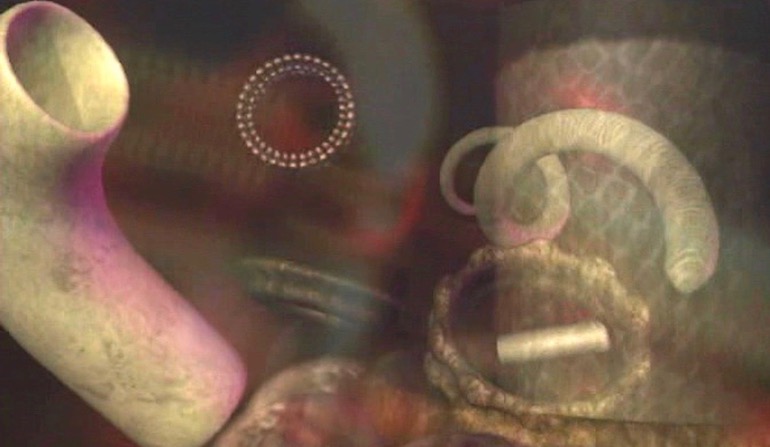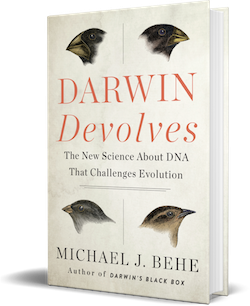 Intelligent Design
Intelligent Design
Darwin Devolves, Again: Study Finds Bacteria Eject Their Flagella to Avoid Starvation

Michael Behe illustrates the theme of his new book Darwin Devolves with a pithy illustration. If you’re low on gas in a remote place, and gas mileage is your most important priority, you could take off the doors and remove the hood to get better mileage.

The lesson is that organisms can sometimes survive by breaking and blunting the actions of pre-existing machinery. This strategy is much more likely to work under stressful conditions, moreover, than waiting for a beneficial mutation to show up. Here is a perfect example.
The bacterial flagellum, a trusty icon of intelligent design, corresponds to the car doors and hood in this true version of the gas mileage story. Eleven authors writing in PLOS Biology found that “γ-proteobacteria eject their polar flagella under nutrient depletion, retaining flagellar motor relic structures.” When there’s nothing to eat, these bacteria are willing to toss off their flagella and plug the hole in order to save energy. If you were out on a lake, would you unlatch your new Yamaha F250 4.2-liter V6 outboard motor and let it drop to the bottom? You might if the boat was taking on water and was about to sink, and you were about to die.
In the face of starvation, bacteria must minimize their energy use. Here, we describe our unexpected finding that some bacteria take the drastic measure of ejecting their flagella in response to nutrient deficiency. Bacteria continually assemble flagella as propellers — unrelated to eukaryotic flagella — rotated by rotary motors embedded in the cell; continual rotation and assembly can consume up to 3% of a bacterium’s energy. Using electron cryo-tomography, a technique that provides high-resolution 3D images of intact bacteria, we were surprised to find partial flagellar motors in bacterial cells that were rare when nutrients were abundant but became common when nutrients were scarce. A variety of clues led us to hypothesize that these structures were relics of motors whose flagella had been ejected, which we confirmed using a genetic approach. Curiously, flagellar relics — which would otherwise be open portals through which the contents of the bacterial periplasm could leak — were plugged by an unidentified protein, presumably as a preservation measure. We speculate that flagellar ejection saves the bacterium from the costs of continuously assembling and rotating its flagella, as a last-ditch survival attempt. [Emphasis added.]
This is perfect. How can these authors possibly recover Darwinism from their observation? Behold one of the best illustrations of spin doctoring to come along recently: “Our work provides a striking example of evolution arriving at a functional yet unintuitive solution to a problem.”
If tossing an outboard motor out of the boat and letting it sink to bottom of a lake is a “striking example of evolution arriving at a functional solution to a problem,” then Darwin’s tree is not going to grow very well.
Save Energy
There’s more in the paper to vindicate Behe’s “First Rule of Adaptive Evolution,” namely, “Break or blunt any functional coded element whose loss would yield a net fitness gain.”
Ejection, therefore, is a drastic but potentially necessary survival mechanism for those daughter cells that inherit the burden of old, undiluted, fully-flagellated poles…. We suggest that flagellar ejection is a mechanism to reduce the number of flagella on a cell pole. Not only do active flagella require energy for torque generation, but flagellar assembly is a constant process and a constant drain on cell energy. Though drastic, decreasing the number of flagella by ejection would be an effective energy conservation measure.
Plug the Hole
The authors found, also, that bacteria actively plug up the hole where the flagellar rod was, so that the cell contents don’t leak out. They don’t know what the plug is made of, other than some kind of protein. Perhaps the cell stuffs whatever is around to stop the leak.
Notably, an extra density in the relic structure plugged the P-ring aperture in the position that was previously occupied by the trans-periplasmic rod. Comparison of the flagellar and relic subtomogram averages confirmed that this density was unambiguously an additional protein absent from intact flagellar motors…. We conclude that the plug is an as-yet unidentified protein that plugs the P-ring aperture concomitantly with flagellar ejection to prevent periplasmic leakage.
If the boat is still leaking from the mount after you dumped the outboard motor, that’s your next emergency: stop the leak. Why doesn’t the cell disassemble the motor in an organized way? Here again, Behe’s principle is vindicated, even if the authors ascribe it to evolution:
The alternative strategy to prevent periplasmic leakage would be disassembly of the entire relic structure and resealing of the outer membrane, requiring evolution of an intricate machinery for proteolysis of all components. Evolution is a tinkerer, and plugging the hole is a considerably more trivial solution than orchestrated disassembly, particularly given that retaining plugged relic structures is unlikely to be detrimental to the cell.
The point: it’s much more likely an organism will take instant, drastic action to survive than wait for “intricate machinery” to emerge for “orchestrated disassembly” of the flagellum. This is precisely Behe’s point. Better to stay afloat without an outboard motor than to sink with it.
As for evolution being a “tinkerer,” Jonathan Witt quipped here:
In garages when such tinkering breakthroughs occur, there’s always a designing intelligence hard at work. But in Kenneth Miller’s magical evolutionary garage, all this ingenious tinkering happens by magic. Sprinkle a little Darwinian pixie dust and a few million years onto the needle complex and, presto, you get a bacterial flagellum motor.
The scientists confirmed that the remnants found are truly discarded relics of flagella, not assembly intermediates. Bacteria, unlike boats, contain the instructions and toolkits for building new flagella “outboard motors” when conditions improve. The bacteria that this team studied were observed under conditions of nutrient depletion. Pieces of flagella were found everywhere, and each hole had a plug in it. One can imagine a boater’s safety instruction book saying, “Warning: in case of emergency, disconnect the motor and let it go. Plug the hole with any substance on hand. Failure to do so may cause death.”
Implications for Type III Secretion Systems
Speculations about an evolutionary connection between the flagellum and the Type III Secretion System (T3SS) hark back to the Dover trial, where Kenneth Miller tried to imagine that irreducibly complex structures could emerge through functional intermediate stages. Subsequent work showed that the T3SS arrived later and could not be an evolutionary precursor. In this new paper, the subject comes up again:
Although we cannot rule out the different mechanisms of secretion — i.e., Sec and the flagellar type III secretion system — segregating relic structures from axial structures actively during assembly, such an operon structure would likely face considerable selective pressure to fragment into separate modules representing discrete, independent structural components; operon structure is well-known as a hallmark of structural co-assembly.
The authors never speculate that the T3SS is an evolutionary intermediate. So far as they could tell, flagellar ejection acts independently of the T3SS. In a mutant strain they devised, “no relic structures were seen, a final confirmation that these structures cannot be assembly intermediates.”
Conclusion
Here we have an excellent illustration of Mike Behe’s thinking. Indeed, in an ID the Future podcast last month, he explained that Darwin, without evidence, presumed that random variation and natural selection were adequate for producing highly complex structures. Other exotic “add-on” processes (evo-devo, neutral theory, and natural genetic engineering), Behe shows, each defer to Darwin’s original view about the creative power of unguided natural processes — but each of these, in turn, reduce to chance.
In his first book, Darwin’s Black Box, Behe introduced the bacterial flagellum, which became a potent symbol of irreducibly complexity. Welcome back the molecular outboard motor that made the case for intelligent design in 1996 and continues to do so today.
Image credit: Illustra Media.
